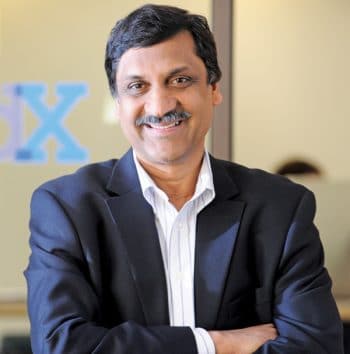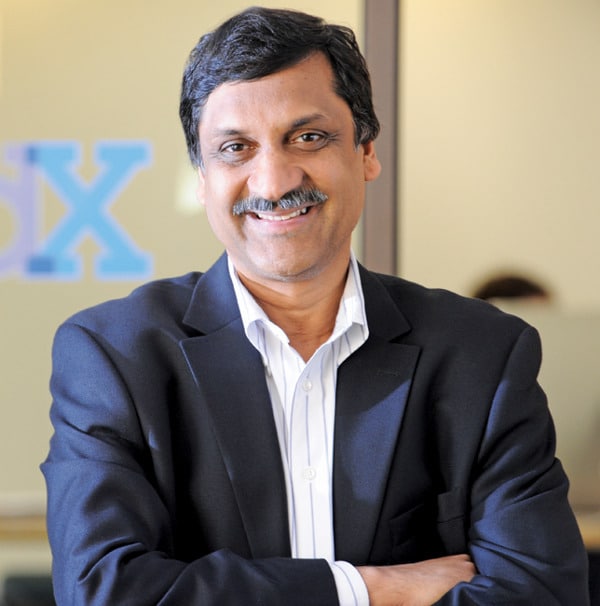
Today, MOOCs or massive open online courses are transforming the education environment. One of the pioneers in the field, the MIT and Harvard University-backed edX, has been very successful with its Open edX that offers a spectrum of courseware to all. Jagmeet Singh of OSFY talked to Anant Agarwal, CEO of edX and MIT professor, for the details about the online platform. Edited excerpts:
Q What does edX have for the Indian market?
Ours is a non-profit organisation and a learning website, where anybody can come and learn for free. We have around 900,000 students from India, and in total more than eight million students from all around the world. The share of the Indian market is about 11 per cent, and India is second only to the US, which accounts for 30 per cent of our students. Therefore, India is a gigantic market for us.
The reason why Indians are very exciting is that the courses we have are quite useful and in demand worldwide. For instance, as computer science is very popular in India, you can take a fantastic course based on computer science simply using our online platform. You can choose introductory programming from Harvard or MIT, right from our website. Likewise, you can take some advanced courses related to frameworks like Ruby on Rails from Berkeley, or basic courses to learn about computers such as an introduction to computer science from IIT, Bombay.
Apart from computer science, we have courses for data science, which is another hot area. Whether it is data analytics, business analytics or the analysis of data, we have many job-oriented data science programmes on edX. These are from Columbia, Microsoft, and so on.
We also have business and language courses (such as learning to write well and business English), which are very popular on our platform. We have also launched a course on TOEFL preparation. This new programme comes directly from ETS, which is the organisation that offers the TOEFL exam, and lets students prepare for TOEFL for free.
Many students are taking these courses and getting jobs all across the globe. It is hard to find these courses locally in India but, with a platform like edX, anyone with a computer and an Internet connection can join them and nurture their career.
Q What are the main challenges in maintaining an online course platform?
We are non-profit, and we make career-oriented courses available for free. Offering a free course is quite challenging, because it costs a fair amount of money to maintain and run a course. We have to pay the hosting fee to a hosting provider like Amazon. Also, each course has a faculty member and teaching assistant who answers questions on the Q&A forum.
Therefore, our biggest challenge is to generate sufficient revenue to sustain and make the courses available to the public.
Q Does using open source solutions help edX solve the challenge of generating revenue?
We don’t take money from venture capitalists because if you do that, you need to deliver a return on the investment in a short span of time. It is hard to get a massive return on investment when you are giving things away for free. At edX, we not only offer courses for free, but have also made the online platform available for free as well. This includes the platform software as well as some analytic tools and mobile apps that are all available for free to the world.
To maintain the integrity of the platform and offer free services, we do several things. We use the open source community to improve many of our existing features. A large number of people from the open source community are providing support, contributing back to the software base and helping us quickly improve edX. So that is a huge win for us.
Apart from utilising the power of the open source community, we launched a new programme last year to translate courses into credit. Called MicroMasters, the initiative allows you to get an online credential from Massachusetts Institute of Technology (MIT). If accepted to the on-campus master’s programme, the credential converts directly into the one-semester worth of credit. Now that MOOCs translate into the credit from top universities like MIT, we have to build features into the platform to maintain the integrity and prevent instances of cheating. So we’ve integrated many mechanisms to restrict cheating practices. Numerous open source ecosystem partners are also building some advanced systems that are helping us solve some big operational challenges.
Q Why was there a need to launch Open edX, when you already had edX in the space of MOOCs?
EdX uses a platform software, and we could just leave edX for the public. However, many people suggested that rather than developing software from scratch, we could share our software. So we introduced Open edX. This lets anybody take our code and launch their own website for education.
Jordan, Saudi Arabia and Israel have already deployed Open edX and launched their educational courses online. In India, premier institutions like IIT, Bombay, have used Open edX and designed a site particularly for a teacher training programme. Many government agencies in India and across the globe are also thinking of deploying Open edX.
We think that by making edX open source, we can maximise the good that we are doing in the world instead of hiding the software and keeping it just for ourselves. If we were a for-profit company, then not giving away the software would be a good thing to do. But this is the best way for a non-profit organisation to reach a massive audience—by offering an open source solution.
Q What are all the open source technologies behind Open edX?
Open edX is based on some foundational cloud systems such as Apache, Python and Django, among others. Also, there are tools for e-commerce and for assessments. We are also offering APIs to let third-party developers integrate our sources into their projects. There is a huge business ecosystem around edX, but anything that we develop, we make it open source.
The original technology behind edX was based on Python and Django. We also used Nginx for the Web software and deployed Amazon Web Server. Similarly, the present platform has open source technologies like JavaScript and HTML5 on the design front and Ruby on Rails for the discussion forum.
All in all, we can say edX is powered by Open edX and that is available for free to the world.
Q How easy is it to develop a solution like edX?
We started edX in 2012. It is very challenging to build a non-profit organisation and hard to raise money if you are offering anything free to the public. Building a non-profit model is not easy because there is no standard model for investment. But we were grateful to MIT and Harvard. We could not launch as a non-profit without support from both these institutions.
Today, we have the support of more than one hundred institutional partners, including some of the top universities in the world.
If you build software that is only used by you, then you can focus just on that software. But as we made it open source at edX, we have a team that is focused on Open edX and is maintaining the Open edX community to generate traction from various engineering resources. This certainly complements our own efforts at edX, because sometimes people want some support and help for particular features that are also useful for edX.
Q Do you think MOOC providers like edX will transform the traditional classroom culture in the coming future?
We are transforming the classroom culture in many ways. I call this process of transformation of traditional classrooms and universities ‘unbundling’. If you look at a traditional university today, it is one bundle. You need to start in the first year, go through various sessions and then finish after some time, say three or four years.
We are partnering with various worldwide institutions and creating more hybrid solutions that are unbundled. So we are trying to unbundle the three Cs—the clock (or the time), curriculum and credentials.
Through MicroMasters, we are unbundling the clock and offering students education in a shorter span of time than any traditional university. We are also unbundling the credentials using solutions like MicroMasters, and enabling students to complete a masters programme by spending half the time and effort as well as at two or three per cent of the total normal cost. Besides, we are unbundling the curriculum by offering online content to students.
Most universities are now moving in the direction of blended education, which combines both online and in-person teaching. Presently, nine out of ten undergraduate students are using edX as part of their campus curriculum at MIT. In the next 20 to 30 years, all education is likely to become blended.
Q What are your views on the education system in India? Also, how can we improve the present system using advancements like edX?
The education system is not perfect anywhere in the world. There are many challenges in the education system worldwide; India has its own challenges. Indian professors and teachers are quite dedicated. Likewise, institutions like the IITs and IIMs are in line with some leading universities overseas.
However, there are challenges in the style of teaching. In India, students need to memorise their course material. We need to find ways of changing how to teach in order to help students understand their course instead of just memorising the material. Further, once you go beyond some of the top universities in India, the quality of education you get is very questionable. Most Tier-II and Tier-III universities do not have enough faculty to teach different subjects.
Universities in India should allow students to take some online courses, especially in the areas they do not have their own faculty. Local education institutions should also let their students take a full course through an online platform like edX, but appear for examinations under a local teaching assistant. We are already seeing some success in using edX to improve the Indian education system.
Teachers and professors can take courses about using blended learning on edX to learn how they can integrate these learning methods in their teaching practices. This will uplift the education system.
Q Countries like Jordan, China and Israel are already using Open edX to launch their national education platform. What about your plans for India?
We are in talks with certain sections of the Indian government and would be delighted to work for millions of Indians. We would love to see the government deploy Open edX and launch a national platform to spread the next generation of education in India.
The Tatas have already announced that they are set to launch a platform using Open edX for high-school students. The same platform can be used for skills, college education and teacher training.
Q How do Indian developers benefit from a platform like edX?
Many companies all over the world are building on Open edX and providing services to corporations and governments, for a certain fee. Entrepreneurs and software developers in India can utilise the same platform and start offering some new learning models. There is a vast ecosystem and many companies worldwide are utilising our software to garner profits.
Q Last of all, how can edX help the jobless skilled workers in India?
I would encourage all the jobless skilled workers to go and take courses on edX. We have courses to nurture many in-demand skills. These are designed by institutions like IIT Bombay, MIT or Berkeley. In fact, just this summer, we’ve launched some of the hottest job-related courses to reduce unemployment.
You don’t need to spend hours sitting in a classroom to learn something new and interesting. Instead, all you need is an active Internet connection to enhance your skills using edX.




